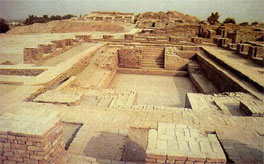Ashok Sridhar is a NRIOL featured columnist. He pens "The Ashok Sridhar Column". To read about Ashok Sridhar, please click here.
Part I of this series of articles on Indian architecture deals with the civil engineering and architectural aspects and advancements prevalent in the Indus - Saraswati valley civilisation.
The Indus - Saraswati valley civilisation (from 4th to 2nd millennium BC), popularly known as the Indus valley civilisation or the Harappan civilisation, peaked between 2600 BC and 1900 BC. It was previously thought that this civilisation flourished along the banks of the Indus river. But recent discoveries and theories suggest quite authoritatively (albeit not conclusively) that there was another major river, the Saraswati, between the Yamuna river in the east and the Sutlej river in the west, that also served as a cradle for the abovementioned civilisation. The course of this river, south of and rather parallel to that of the Indus, has been studied and mapped by geological exploration as well as by remote sensing and also by radioisotope dating of the water still found under the river's dry bed in the Rajasthan desert. This river is mentioned a number of times in the Rig Veda. Many scholars identify the Vedic Saraswati river with the seasonal Ghaggar - Hakra rivers in India and Pakistan. It is believed that the Ghaggar - Hakra rivers had the Yamuna and the Sutlej rivers as their tributaries. Due to tectonic movements, the path of the Yamuna river was diverted towards the Ganges river and the path of the Sutlej river, towards the Indus river. These changes occurred somewhere between the 3rd and the 2nd millennia BC. As a result of these findings and theories, some historians are advocating the renaming of this civilisation as 'Saraswati - Sindhu civilisation', Sindhu being the Sanskrit equivalent of Indus.
The map below depicts various Indus - Saraswati valley sites and the most likely location of the Vedic Saraswati river.
This civilisation was the largest of the four ancient civilisations (others being the Egyptian, the Mesopotamian and the Chinese civilisations), covering an area greater than the combined areas of the Egyptian and the Mesopotamian civilisations.
Though it was really advanced, it has not yet been given the due credit, because of the fact that the Indus - Saraswati script has not yet been deciphered.
It is believed that the decline of this civilisation coincided with the drying up of the Saraswati river.
Civil engineering and architecture in the Indus - Saraswati valley civilisation
The Indus - Saraswati civilisation was the world's first to build planned towns with underground drainage, civil sanitation, hydraulic engineering, and air-cooled constructions. Whereas the other ancient civilisations of the world were small towns with one central complex, this civilisation had the distinction of being spread across many towns, covering a region about half the size of Europe.
Many cities of this civilisation had a level of architectural planning that was unparalleled in the ancient world. The cities were laid out in a grid-like pattern, with the orientation of streets and buildings according to the cardinal directions. To facilitate the access to other areas and to separate private and public areas, the streets were particularly organised. Proper underground sewerage systems built using precisely laid bricks and efficient water management systems were far ahead of their times. In fact, even smaller towns had impressive drainage systems.
There were a number of wells built with trapezoidal bricks to prevent collapse due to the pressure exerted by the surrounding soil. In Mohenjo-Daro (in present-day Pakistan), there was a 'great bath' that served as a public bath probably attached to a place of worship. The remnant of this bath is shown below
Other prominent constructions include dockyards, granaries and warehouses. There were also massive, walled citadels, although their purpose is not quite clear.Since there are no conclusive evidences of kings, armies or castles, these walls could have been constructed to protect the city from flood waters. Though these citadels were massive structures, there were no other huge monuments or temples, showing that the Indus - Saraswati people were not megalomaniacs.
This is in sharp contrast to this civilisation's contemporaries namely the Egyptian and the Mesopotamian civilisations. If there is an overwhelmingly impressive feature about the constructions of this era, it is the standardisation of brick sizes. The mud bricks followed a standard ratio of 4:2:1. Their actual dimensions varied, depending on the type of structure (houses, fortifications etc), but the ratio was always maintained. While the archaeological excavations have revealed that the walls of houses were, on an average, 70 cm thick, fortification walls that are several metres thick have also been unearthed. Standardised bricks aside, undressed and dressed stones were also used in large scales. The stones were almost perfectly dressed using just copper tools, as iron tools were not yet known. The houses are an amazing example of the skills of the native people in adapting to the local environmental conditions by ingeniously producing an architecture that was in harmony with the environment. The houses were planned as a series of rooms opening on to a central courtyard. This courtyard served the multiple functions of lighting the rooms, acting as a heat absorber in summer and radiator in winter, as well as providing an open space inside for community activities. There were no openings toward the main street, thus ensuring privacy for the residents. In fact, the only openings in the houses were rather small - this prevented the hot summer Sun heating the interiors of the houses. Archaeological excavations have revealed that even 5000 years ago, every house had its own bathroom and drainage! In cities like Mohenjo-Daro, the drains from each individual house emptied into a covered collective drain, indicating the importance given to hygiene. There are also evidences of stairs, indicating the existence of buildings with two or more levels. There were a few houses that were particularly large with up to 7 rooms, but they co-existed with modest houses, indicating the social equality. The politicians and city planners of today would well to understand the Indus - Saraswati valley civilisation in detail and learn a lesson or two on social equality and proper city / town planning. While today's Indian cities are anything but clean and organised, the Indus - Saraswati people placed utmost importance on organisation as well as hygiene.
REFERENCES:
For a listing of past columns by Ashok Sridhar, please click here.



